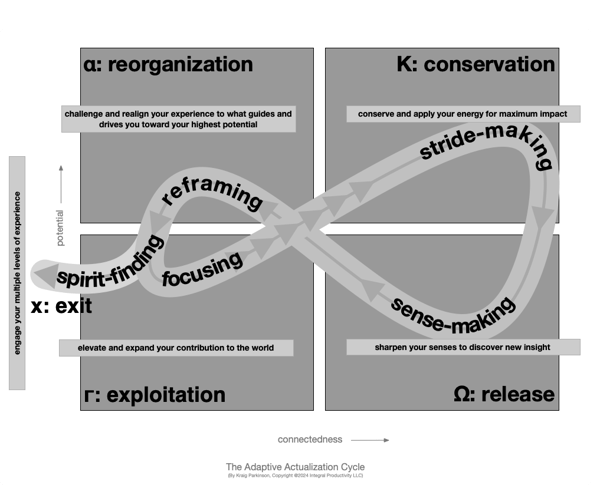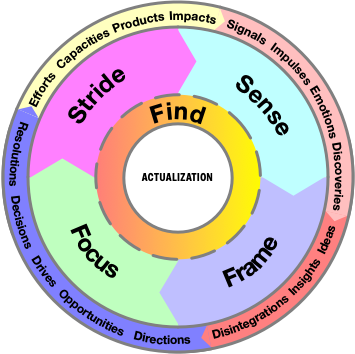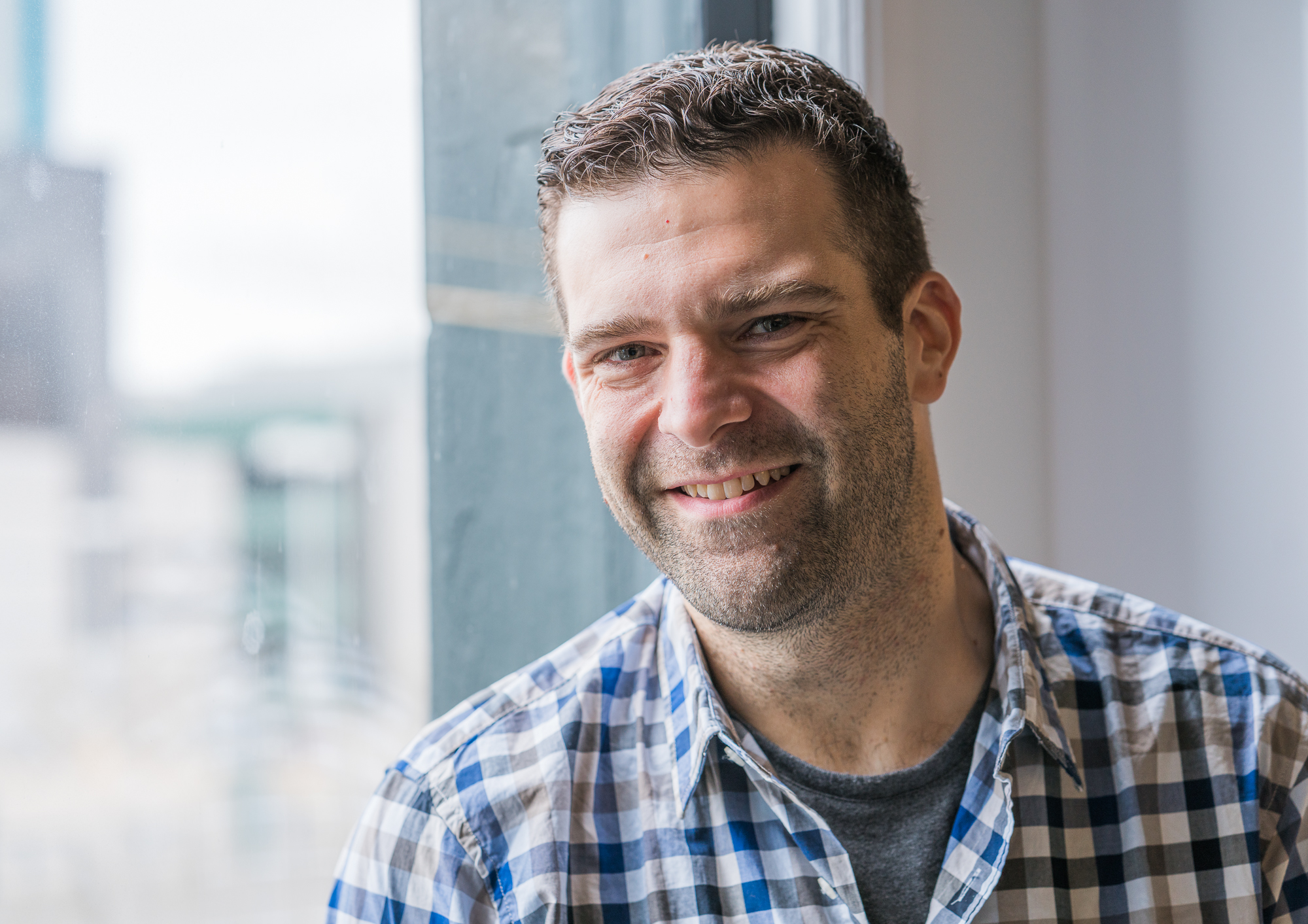What is adaptive actualization?
Adaptive actualization is a methodology that develops people to fulfill and extend their potential while living authentically. Creating meaning in every moment is the core of an adaptive actualization strategy that helps you find true joy in life.
Table of contents
Adaptive Actualization Overview
The adaptive actualization methodology is the strategic framework for continuously fulfilling your individual and collective potential by learning to see the meaning in every moment. It's about inspiring growth and revolutionary change for a better life and humanistic culture.
Why? Because when you learn to see tensions and anxiety as a pathway toward happiness instead of something to avoid, you grow.

The adaptive actualization methodology can be applied in five ways:
- Sense/Sense-Making: observing yourself and the world in high fidelity so you can get the signals and feedback you need to become a better, trusted advisor to yourself and others
- Frame/Reframing: identifying, challenging, and redefining your perceptions of experience so you can find more options than the norms for engaging in the world
- Focus/Focusing: aligning your psychic capacity—vision, mission, and intended actions—toward the greatest actualization within your observed environment
- Stride/Stride-Making: developing and deploying the habits, systems, and resources that help you conserve and apply your energy for maximum impact
- Find/Spirit-Finding: seeing and engaging yourself across levels of experience that enable self-transcendence
Why is adaptive actualization important?
When you make a change—one that allows you to express yourself more authentically or fulfill your potential and create even a small impact on your life or the lives of others—and you celebrate the whole journey of positive disintegration for yourself, it opens you up to make more changes, creating a self-sustaining loop. Similarly, when you share that change with others, it sets an example and engages others to support you and pursue their own change to share back. This is how your actualization builds momentum, which is why the adaptive actualization strategy serves as a strong foundation for your flywheel.

To identify and make those changes effectively, you need to shift your personal development focus toward adaptive actualization strategies. From Integral Productivity Founder Kraig Parkinson's perspective, "If you can become efficient and effective at gathering and processing high-fidelity signals about your experience, you'll get compelling insights into how you can think and act differently in the world that is more connected to your genuine and authentic self. The more you focus on and take those actions, the more you'll be in love with the life you're living and bring others closer to you, too."
By developing your platform of personal development frameworks, productivity techniques, personal apps & automation, and a supportive community, you can convert any experience into a powerful opportunity for actualization that gives you autonomy over your experience and cultivates genuine connections with others. Embracing the adaptive actualization methodology serves as a strong foundation for building momentum to develop yourself into your highest potential and make the greatest impact on the world.
How does adaptive actualization work?
Adaptive actualization strategies will help you effectively find meaning in every moment without having to wait. Keep your flywheel spinning and help yourself and others actualize better.
Sensing Strategies
Adaptive actualization strategies that help you sense more about yourself and the world around you are tied to your reflective and discovery capacity.
To sense more about yourself, start by looking at your execution effectiveness: your ability to control and get perspective on fulfilling the demands you place on yourself and the world places on you. Examples include looking at how well you use your time, seeing how long items sit in your inbox before you process them, the number of active, on-hold, stalled, or complete tasks and projects you have, how long it takes to get your work finished, and how well you completed work to a standard.
Develop your inner sensitivity to understand yourself at a deeper level beyond your observable behavior. Look at your emotional response to what you've experienced or done, consider how it sits with you, and consider what tensions or trauma were raised. These often have valuable insight into what might be inhibiting your authentic self.
To understand the world better, seek out new information, knowledge, and perspectives from many sources and levels of perspective. Balance first-person points of view with neurobiology, psychology, and critical theory to give yourself a multi-decade or generational perspective of how the world works. You'll start to see the world in a new light and realize there is no "one right way."
Framing Strategies
When using adaptive actualization strategies to frame your experience, think of your current model of the world as your experience architecture, a multi-dimensional structure that your experience passes through to create meaning. For example, you might perceive something differently depending on the time span you apply, be it minutes, hours, days, weeks, months, years, decades, or generations. Perhaps it's the complexity you perceive in some or all parts of the system. Or maybe different based on what you attribute to the environment, your behaviors, capabilities, beliefs and values, identity, and spiritual purpose. Even the number and kinds of people involved an experience changes how you see things. Each frame offers a unique meaning, so being aware of which frames you use or favor gives you new awareness.
Some framing strategies help you identify and determine which frames have outlived their usefulness or meaning to you and how to move beyond them. Realizing that a familiar and internalized model of the world is actually inhibiting your authentic self or denying your humanity may be a sign that it's time to let it go or at least reprioritize its importance in how you think and operate.
Other framing strategies are important to help you see, assess, and increase your capacity to handle change. When you connect with your own internal resourcefulness, survival strategies, and self-care, you can learn to hold more space for yourself and others through more complex and higher-stakes transformations.
Focusing Strategies
Adaptive actualization strategies that create focus make sure people are inspired, compelled to act, and manifest tangible change.
Focusing strategies that drive to a dream state offer a north star, something that gives yourself and others something to reach toward even in the darkest of times. When these states are articulated around a humanistic vision—a specific vision for the future that brings out the best in everyone while leveraging their differences and gifts—it draws on your inner drive to help others.
A mandated mission is an important focusing strategy for amplifying that drive. It's getting in touch with and dialing into what you sense to be your specific life purpose and direction, along with the degree of commitment you bring to a course of action and persevering through challenges.
The focusing strategies that manifest the change you want to see and the true leadership you bring involve revolutionary actions. It's your willingness to defy norms and conventions, be heretical, and withstand opposition to see your vision through and fulfill your mission.
Striding Strategies
Adaptive actualization strategies that help you make the best strides are ones that level you up beyond individual, heroic actions to achieve systemic impact.
Striding strategies that help you directly embody your actualized self are centered around mindful habits, routines, and deliberate practice. They create the muscle memory needed to make desired behavior automatic and easy to do while remaining intentional about why you're doing it.
At the same time, don't try to keep it all in your head. In today's world, there's too much complexity to do that effectively. System-driven performance is a striding strategy that enables you to use technology and even build your own solutions to act as your "outboard brain" and give you the contextual reinforcement you need to stay on track.
Lastly, the mark of a striding strategy that truly goes beyond individual contribution to affect others is one that helps you make your presence known even when you're not there. This means developing and managing your own personal products—from points of view and perspectives to checklists and lessons to software and other automation—that build on your unique knowledge and wisdom to enable others to be their best.
Finding Strategies
Adaptive actualization strategies aren't just about infinite repetition. The more you actualize yourself and adapt, the more you find in your transpersonal experience—seeing the world beyond the conventional self across states of being, time, and space. As either Pierre Teilhard de Chardin or G. I. Gurdjieff put it, "We are not human beings having a spiritual experience; we are spiritual beings having a human experience."
Deliberate exits and pivots are an important set of finding strategies. There are times when you'll realize that a certain space—a job, a family unit, a community—inhibits your continued actualization, and you decide to leave it, either to explore a liminal space or search for another. Making these exits with gratitude, grace, and compassion for who and what you're leaving behind can make the transition easier for everyone.
Other finding strategies help you decide when its time to double down on your current path, expanding the capacity you place on the commitments where you have extraordinary passion and drive while softening your commitment to others. These are best balanced with sensing strategies to ensure that you don't lose sight of essentials that give you strength.
Lastly, some of the most profound experiences we have in our actualization are realizing when we are operating at another level of being. These finding strategies include evolutions and the transcendence of your ego into new states. Sometimes, these are spontaneous moments brought on by a combination of experiences you often can only see in hindsight. When assisted by intense meditation or sacred medicine and rituals, the support of the sensing, framing, focusing, and striding strategies are essential to supporting reintegration.
Get Started with Your Adaptive Actualization Strategy
As a person trying to actualize, your goal is to sense what's changing about your experience, frame your experience in a resourceful way, focus your energy in a clear direction, stride toward your desired impact, and find new ways to experience the world.
You also partner with your friends, family, colleagues, and community to keep the flywheel spinning effectively to help yourself and society keep growing. It's a big job, but the adaptive actualization methodology, personal coaching, and Integrators Community have you covered.

| Sense Tools | Frame Tools | Focus Tools | Stride Tools | Find Tools |
| Project and task management solutions, patterns, and plug-ins Calendar architecture and auto-schedulers Note-taking & reference systems
Journals and templates
Measurement & monitoring patterns
Suggested reading
|
Cause-and-effect diagrams Belief systems Zettlekasten Perception frameworks Belief reframing patterns Ecosystem maps Grounding practices |
Visioning tools and collaboration boards Issue trees and decision trees Storytelling frameworks and templates Theories of change Scenario planning |
Stackable habit patterns and trackers Programmable session timers Smart devices Personal and home automation platforms Cognitive product patterns and templates |
Ego development theory and maps Crucial conversations, confrontations, and negotiations Realignment and reintegration solutions Insight and meditation retreats Spiritual guides Sacred rituals and plant medicines |
Sense
You need to know how well you're staying on top of what you're doing and getting done. Use our recommended project and task management solutions, patterns, and plugins to bring it all into perspective. Connect them with our calendar architecture and recommended auto-scheduling tools and integrations to keep your work in sync with the time you have available. Keep important notes and files at your fingertips while getting reference material with our note-taking templates and tools.
Stay connected to your emotional perspective with our recommended journal tools and custom, curated templates for any situation. Open yourself to new perspectives with our suggested reading and influences along with our recommended cognitive productivity solutions. Track and manage your progress at every level using our measurement and monitoring patterns. Throughout every phase of your actualization experience, you'll have a clear awareness of what's working and how well.
Frame
Learn to see how you perceive the world by modeling and testing your own experience architecture using our diagramming patterns and belief systems mapping solutions, so you can bravely test your boundaries. Explore new ideas and tie together concepts using our creative writing approaches that feed your generative thinking. Discover new frames of mind by learning and practicing to use our recommended perception frameworks, so you're never without another perspective on the world. Work through seemingly intractable issues and tensions with polarity maps and reframing patterns that help you break from unhealthy patterns.
Focus
Define your vision for the future with visual boards and written exercises that shape your focus and keep you pointed toward your highest potential. Use storytelling frameworks to get others consistently excited, on board with, and partnering with you on your vision for the future. Break down, find, and tune into your motivational drivers with analytical frameworks that help you put your various strategies and tactics into perspective. Map out multiple paths to viable futures with scenario planning and theories of change.
Stride
Set up, establish, and manage stackable habits that help you build the momentum and support you need to get into the flow faster and take less important things off your mind. Establish rituals and routines that keep your momentum and passion high while keeping the mundane at bay. Set up your technology to work for you in every context, so you can keep your attention and creative energies where they make the most impact. Build products that extend your influence beyond your immediate presence well into the future.
Find
Make graceful exits from environments and commitments that inhibit your actualization while repairing and sustaining your important bonds and relationships. Use our realignment and reintegration tools to direct your energy and commitments to go deep into where your passions and insight pull you most. Share and glean experiences with others who have taken journeys to expand their consciousness.
By combining the adaptive actualization methodology with Integral Productivity personal services, you’ll more consistently live your most authentic life, fulfill your potential in all the ways you can imagine, and bring others along to make the meaningful change you want to see in the world.
Learn adaptive actualization now
Sign up for a free consultation to learn adaptive actualization, access free tools to try adaptive actualization yourself, and get started. Live authentically and fulfill your highest potential with the adaptive actualization methodology.
